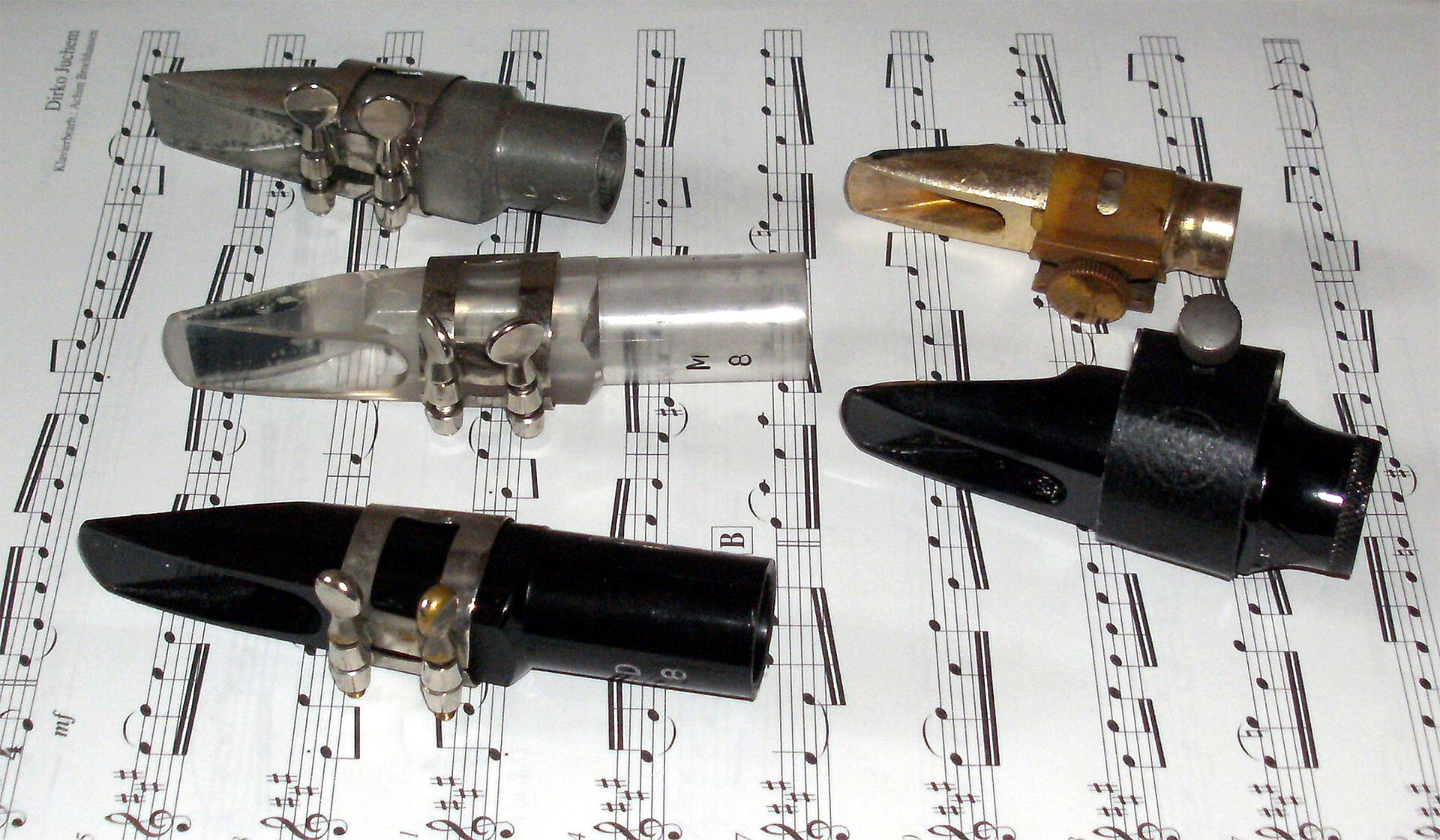Introduction
Choosing the right mouthpiece is crucial for a signature saxophone sound. The saxophone’s response needs to be smooth, the keywork should work like clockwork, and the padding must close all holes completely to ensure perfect intonation. The sound itself, however, is essentially determined by the mouthpiece and the reed (as well as by the player’s embouchure).
It is therefore a pity that fewer and fewer sax players devote any time at all to the selection of a mouthpiece. During my workshops, I get to talk to a lot of sax players who are still using the mouthpiece that came with their instrument. What a pity, since those mouthpieces are only meant for testing the instrument in a store, possibly also for absolute beginners. They are definitely not enough for playing in a band, a music society or at a gig. I can only encourage you to look for a more appropriate mouthpiece. Below please find a few hints.
Different Mouthpieces
The first thing you will notice is that mouthpieces are made of a wide variety of materials. Most black mouthpieces are made of plastic, while others use high-quality natural rubber. Metal mouthpieces are available in several flavors: some are made of stainless steel (example: Berg Larsen) or bronze (Otto Link), while others consist of a variety of alloys or compositions.
Generally speaking, rubber or synthetic mouthpieces produce a warmer and smoother tone, while metal mouthpieces sound more piercing, “brighter” and “sharper”.
Careful, though: the sound is not only determined by the material. Other factors are equally important. First off is the “facing”, which determines the instrument’s response. The second is the baffle shape, which can be straight or rounded. This has a strong influence on the response and the sound. And last but not least, the “chamber”, i.e. the mouthpiece’s internal resonator, has a huge influence on the response and sound quality: is it full, with a pronounced midrange, or “bright” and “sharp”?
The “Facing Length”
Allow me to say a few more words about the facing. Two concepts are important here—the facing length and the tip opening. The facing length refers to the distance between the mouthpiece’s tip and the tip of the reed. The tip opening represents the length over which the reed does not touch the mouthpiece.
Most entry-level mouthpieces use a short tip opening (e.g. size “4”). A narrower opening produces a smoother response, the trade-off being a “thin” and unstable sound. More experienced sax players prefer a wider tip opening (between “6” and “8”), because their trained lip muscles allow them to intonate more securely, while the saxophone sound is more stable and fuller.
Give Piece a Chance
Most manufacturers not only use a variety of materials, tip openings and resonator chambers, but also different shapes. The only way to find the right mouthpiece for you is by trying them out!
Before embarking on this quest, you should have clear idea about the sound you are looking for. Are you fond of a delicate, mellow or smooth saxophone, or do you prefer a sharp, piercing and aggressive sound?
The choice of your new mouthpiece will be determined by the sound you are after. For a smooth sound, choose a rubber mouthpiece with a medium tip opening and a larger chamber. For a piercing and sharp tone, I recommend a metal mouthpiece with a wider tip opening and a narrower chamber.
Once you are relatively clear about the sound you are after, you are ready for paying a visit to your favorite music store. Be sure to choose a store that specializes in brass and wind instruments, because you are more likely to find a wider variety of mouthpieces there and precious advice regarding the models most likely to suit your musical preferences. When you explain to a specialist how you would like to sound, he or she will most likely pick 3, 4 or 5 mouthpieces for you, which you should test extensively.
Start by playing a few notes in the middle register, then low notes, a few high notes, and try to decide almost on the spot whether or not you like the mouthpiece. If you have trouble playing the low notes, chances are that you will get frustrated after a few weeks. If 2 out of 5 mouthpieces remain after your initial test, try those out more thoroughly: play your favorite tunes (in the low and high registers) and try to find the one you like best.
Sax Heroes
Are there any sax players or songs with a sound you absolutely adore? Would you like to sound as smooth on your tenor sax as Stan Getz in the song “Girl From Ipanema”, or as tough as Junior Walker in the Foreigner hit “Urgent”? Or do you dream of sounding as slick as Paul Desmond in “Take Five” or as funky as Candy Dulfer in “Lily Was Here”?
If so, try to find out which mouthpiece they use. With some patience and a few hunches, you are very likely to find such information on the internet. Quite a few American websites focus on the equipment used by known sax players.
Careful, though: bear in mind that the mouthpiece your hero uses may not be your best choice. After all, every player has a different muscular system, different lip shapes and a different jaw bone. Still, the information is likely to point you in the right direction. If a mouthpiece with a tip opening of “8” suits one sax player, the same size “6”, “7” or “9” model may very well be your best choice.
So once again: try them out and have fun!
All the best, Yours,




